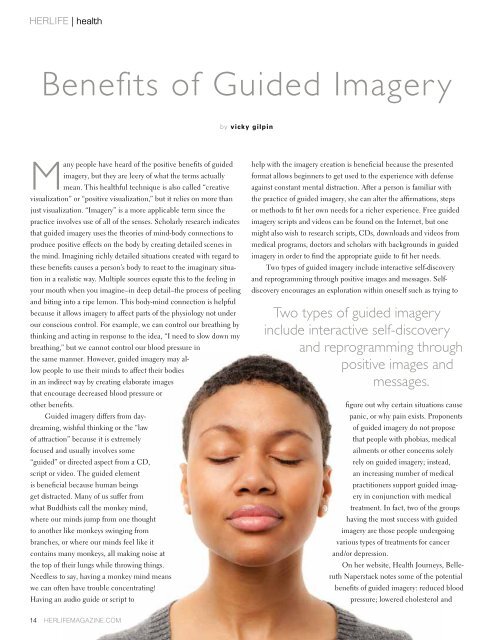You also want an ePaper? Increase the reach of your titles
YUMPU automatically turns print PDFs into web optimized ePapers that Google loves.
herlife | healthBenefits of Guided Imageryby vicky gilpinMany people have heard of the positive benefits of guidedimagery, but they are leery of what the terms actuallymean. This healthful technique is also called “creativevisualization” or “positive visualization,” but it relies on more thanjust visualization. “Imagery” is a more applicable term since thepractice involves use of all of the senses. Scholarly research indicatesthat guided imagery uses the theories of mind-body connections toproduce positive effects on the body by creating detailed scenes inthe mind. Imagining richly detailed situations created with regard tothese benefits causes a person’s body to react to the imaginary situationin a realistic way. Multiple sources equate this to the feeling inyour mouth when you imagine–in deep detail–the process of peelingand biting into a ripe lemon. This body-mind connection is helpfulbecause it allows imagery to affect parts of the physiology not underour conscious control. For example, we can control our breathing bythinking and acting in response to the idea, “I need to slow down mybreathing,” but we cannot control our blood pressure inthe same manner. However, guided imagery may allowpeople to use their minds to affect their bodiesin an indirect way by creating elaborate imagesthat encourage decreased blood pressure orother benefits.Guided imagery differs from daydreaming,wishful thinking or the “lawof attraction” because it is extremelyfocused and usually involves some“guided” or directed aspect from a CD,script or video. The guided elementis beneficial because human beingsget distracted. Many of us suffer fromwhat Buddhists call the monkey mind,where our minds jump from one thoughtto another like monkeys swinging frombranches, or where our minds feel like itcontains many monkeys, all making noise atthe top of their lungs while throwing things.Needless to say, having a monkey mind meanswe can often have trouble concentrating!Having an audio guide or script tohelp with the imagery creation is beneficial because the presentedformat allows beginners to get used to the experience with defenseagainst constant mental distraction. After a person is familiar withthe practice of guided imagery, she can alter the affirmations, stepsor methods to fit her own needs for a richer experience. Free guidedimagery scripts and videos can be found on the Internet, but onemight also wish to research scripts, CDs, downloads and videos frommedical programs, doctors and scholars with backgrounds in guidedimagery in order to find the appropriate guide to fit her needs.Two types of guided imagery include interactive self-discoveryand reprogramming through positive images and messages. Selfdiscoveryencourages an exploration within oneself such as trying toTwo types of guided imageryinclude interactive self-discoveryand reprogramming throughpositive images andmessages.figure out why certain situations causepanic, or why pain exists. Proponentsof guided imagery do not proposethat people with phobias, medicalailments or other concerns solelyrely on guided imagery; instead,an increasing number of medicalpractitioners support guided imageryin conjunction with medicaltreatment. In fact, two of the groupshaving the most success with guidedimagery are those people undergoingvarious types of treatments for cancerand/or depression.On her website, Health Journeys, BelleruthNaperstack notes some of the potentialbenefits of guided imagery: reduced bloodpressure; lowered cholesterol and14 <strong>HER</strong><strong>LIFE</strong>MAGAZINE.COM
















